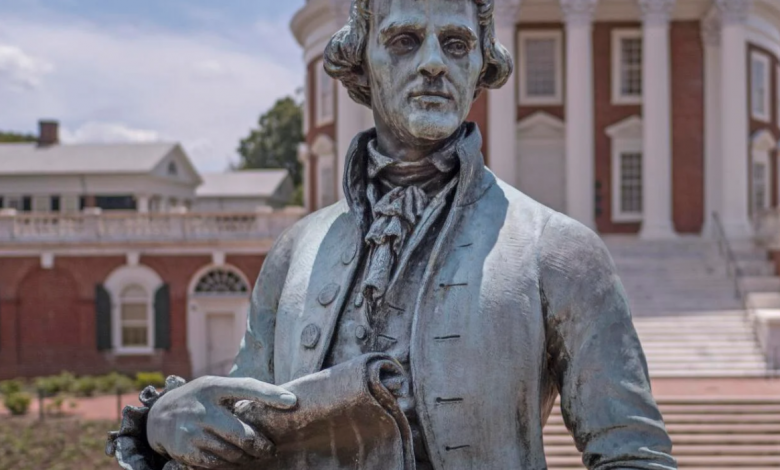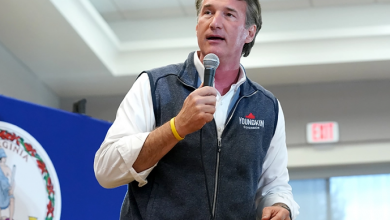Making peace with Jefferson and founders who enslaved people: Is it possible?

Americans, especially Central Virginians, have long had a love affair with Thomas Jefferson. His talents, vision, gracefulness with language, brilliance and even his posture have led people to wax at least semi-romantically about him for centuries.
President John F. Kennedy once quipped that a gathering of Nobel Prize winners was “the most extraordinary collection of talent, of human knowledge, that has ever been gathered together at the White House, with the possible exception of when Thomas Jefferson dined alone.”
Jefferson has especially defined the Charlottesville area, including his beloved University of Virginia. Along with his best friend and hand-picked successor to the presidency, James Madison, and close friend James Monroe, the three were a peerless trinity in the eyes of many Central Virginians. Together, their accomplishments were unrivaled in American history.
But the three also enslaved people. DNA evidence published in 1998 in the esteemed journal Nature showed a strong possibility that Jefferson had a sexual relationship with Sally Hemings, whom he enslaved. Hemings bore at least one of his children and possibly all six, the DNA evidence strongly suggested. Hemings could have been as young as 13 when the sexual relationship began.
That story didn’t make it into middle school history books.
“I mean, he was a pedophile,” said Carliss Chatman, a Charlottesville resident who is a professor of law at Washington and Lee University and one of many who wouldn’t mind seeing less reverence for the man, or at least an accurate history of him. “There’s no way to hide that fact.”
Besides sending Jefferson lovers into Miss Pittypat-like panic, Chatman’s view underscores an inherent tension in the stories about Jefferson and other founders who enslaved people.
“We put them up on pedestals, almost godlike,” said Mary Furlong Minkoff, assistant director of archaeology and curator of archaeological collections at James Madison’s Montpelier, which has worked to tell a much expanded story of the Madisons and Montpelier. “But to be human is to have flaws.”
As the country reckons with the legacies of slavery and racism, revisionists want the full truth to come out about the founders. Thomas Jefferson’s Monticello, James Madison’s Montpelier, James Monroe’s Highland and the University of Virginia now all include stories about the role that enslaved people played in building those places.
Some people want more, such as the renaming of the Jefferson-Madison Regional Library, or the taking down of Jefferson’s statue in front of the Rotunda. Strict fans of the founders have sometimes reacted angrily, saying that the fuller history is unnecessary and sometimes mean.
Chatman, for one, scoffs at that.
“Black people’s feelings are hurt every day,” said Chatman. Seeing roads named for enslavers “doesn’t just hurt my feelings. It changes my entire life.”
For her and many others, telling the full stories of the founders is not just about setting history straight. It’s about informing the future — and moving beyond the corrosive polarization that plagues the country.
Charlottesville and the region were the original settings for the stories told about the founders and the birthplace of the most confounding paradoxes in American history: How could men who believed in freedom and inalienable rights enslave people, deny their rights and create misery that would endure until this day?
The paradox is also at the foundation of the country’s racial wounds — including Charlottesville’s.
Salving those wounds locally has been top of mind since August, 2017. Some people believe that if founder-focused Charlottesville can bind its racial wounds, it could provide hope if not an outright blueprint for how the country can do so, too.
People had known centuries that Jefferson, George Washington, Madison, Monroe and other founders enslaved people. Still, many people revered them. When confronted with thorny political questions, many to this day look back to the revolutionary era and ask “What would the founders do?,” almost as if they are considering what a deity would do.
Jefferson’s star began to dim in the 1990s. The DNA studies that showed Jefferson’s relationship to Hemings tarnished Jefferson’s reputation in some people’s eyes more than the DNA evidence on the blue dress worn by a young intern who had an affair with William Jefferson Clinton. It wasn’t just that Jefferson had a sexual relationship with a teenager or young woman — it was that she was enslaved by him and that she possibly bore as many as six children by him.
At Thomas Jefferson’s Monticello, historians and other staffers, many of whom hold doctorates and some of whom are descendants of enslaved people at Monticello, don’t mind talking about this. They also readily acknowledge the inconsistencies of Jefferson as an author of freedom and Jefferson as a man who enslaved people. They know these conversations can be difficult.
“There are truths that are hard to reconcile, to sit with side by side,” said Gary Sandling, vice president of strategy and chief content officer at Monticello. And yet, even though some of those truths may not have been evident for years, it is important to discuss them now, Sandling said.
On the 250th anniversary of Jefferson’s birth in 1993 — and before the Nature article — Monticello made the decision to “leverage years of archaeological history to tell the fuller story.” This led to guided walking tours that featured the lives and works of enslaved people, instead of keeping the focus only on Jefferson.
That same year, Monticello started an oral history project to learn the fuller truth and to tell the stories about the more than 600 people who were enslaved at Monticello. More than 225 people, the majority of whom are descendants of people enslaved on the mountaintop, have been interviewed worldwide.
And while those interviews and those discussions have sometimes been difficult, they have been honest — and historically accurate, Monticello historians said.
“When we say comprehensive, we mean that,” said Andrew Davenport, a descendant of families enslaved at Monticello and director of the Getting Word African American Oral History Project. “This (place) is actually one of the best places in the world to have these conversations.”
Descendants are especially welcomed back to Monticello, the historians noted. Hundreds now are part of an official descendants group and Monticello holds special days of honor to welcome them. The last one, held June 18, brought together more than 100 descendants. These are joyful and emotional reunions, the historians noted, bringing out stories and connecting people in very real ways.
Monticello has recently hired Mariane Asad Doyle as vice president of diversity, equity, inclusion and accessibility. Doyle said she hopes to build on work already underway at Monticello to make it more welcoming to a wider range of people, including those with disabilities. The site is working on a potential collaboration with UVa and Piedmont Valley Community College to allow all students who attend either school free admission. As part of a program called Museums for All, Monticello this will will offer free admission to those who receive Supplemental Nutrition Assistance Program benefits.
“It’s about how we can eliminate barriers,” said Doyle.
About 30 miles away at James Madison’s Montpelier, the historical and archaeological staff have more recently weathered a storm. Most of the senior staff was fired in April in a fracas about the representation of descendants of enslaved people on the Montpelier Foundation Board. The staff sided with descendants who had been promised half the board seats. Board chair Eugene Hickok ordered president Roy Young to fire them.
In May, pressure from the National Trust for Historic Preservation, which owns Montpelier, forced Hickok and Young to give the descendants half the board seats and rehire the staff. Hickok and Young then resigned.
None of that stress was evident on a recent day in the Pony Barn toward the back of Montpelier, where historians and other staff have their offices.
Hilarie M. Hicks, director of museum programs and senior research historian, said she feels an obligation to the “invisible founders,” or enslaved people who kept Montpelier’s fields full of crops and the tables of the Madisons brimming with the sumptuous foods and good times for which Dolley Madison was known.
While Monticello cites a particular moment when historians and story tellers realized that the historical record needed to expand, Hicks said the change at Montpelier “evolved over time.”
But a dramatic turning point occurred after a $10 million renovation and reconstruction of the mansion in 2003-2004. Nearby cabins that had once been the homes of enslaved people had not been rebuilt. Instead, railroad ties surrounded by grass that had been sprayed with weed-killer marked those homes.
“A descendant looked at that and said, “Oh, Madison gets a $10 million restoration, and my people get railroad ties and dead grass,” said Hicks. “That really struck us.”
As a result, the staff began to think about “the way we thought about the story and what do we want to tell.”
Hicks has pulled together names of enslaved people in the “Naming Project” webpage that started two years ago. She is still at work compiling as full a biography as she can come up with on each of those people.
In the process of collecting the names, stories began to stand out.
“One story that really affected me was a story from James Madison, Sr.,” Hicks said. “Each times one of his children married, “Madison Senior” “gave” enslaved people to his children.
One story emerged about a woman, Eliza, an enslaved mother with five children.
Madison Sr. gave them to his daughter Nelly when she married.
“There was this rearranging of people’s lives so you can give free labor to your children,” Hicks said. “It’s the casual cruelty of slavery.”
In 2017 — two months before the riots in Charlottesville — the museum opened an exhibit that featured stories of descendants of enslaved people at Montpelier. Drawing from a quote of Madison’s acknowledging that a “mere distinction of colour” accounted for the oppressive system of slavery, the exhibit tells real-life stories through the voices of modern-day descendants.
Just down the lane from the Pony Barn offices is the archaeological lab of Minkoff.
She and the staff have catalogued tens of thousands of pieces of plates, keys, wine bottles, jewelry, farming implements, horse shoes and even a child’s thimble, all of which adds to a fuller story of life at Montpelier.
For example, children who were enslaved were often encouraged by their parents and extended families to learn skills so that they would not be sold, and the family split up — thus the thimble, Minkoff concludes.
Minkoff is especially fascinated by a ring made from carnelian stone, found in India but often traded to Africa, she said. The fact that it is carnelian signifies that it is most likely a ring a woman had in Africa and brought with her on a slave ship.
“It’s interesting to understand the uniqueness of the Founding Fathers in this region, but it’s important to understand everybody else who contributed to the founding of our country,” she said. “I don’t think you can fully understand James Madison or Dolley without understanding the people around them.”
After the tensions last winter, Hicks and Minkoff know that not all agree. Montpelier released a list of corrections in mid-July to a story in the New York Post that said, among other things, that the American flag does not even fly at Montpelier.
“The criticism that I’m hearing now is that the only reason we’re talking about slavery is that we’re trying to denigrate the founders,” said Hicks. “That’s not the way to look at it. You can’t understand how American history evolved without understanding slavery. It’s not about casting blame on anybody. It’s about understanding what happened.”
Mr. Jefferson’s University
Of Jefferson’s many roles and contributions, he was said to have been proudest of his role in founding UVa.
He was involved in nearly every aspect of its beginning, from sketching out the iconic Lawn and Rotunda to making sure it would be a university of rigorous scientific inquiry, and one not affiliated with theology. While it is a state university, many alumni and others think of it reverentially as “Mr. Jefferson’s University.”
Even so, some people have called for the statue of Jefferson that graces Grounds to be pulled down. Others wish the university would distance itself from Jefferson.
Jim Ryan, UVa president, isn’t having any of that. Ryan has made clear that Jefferson, including the statue of him in front of the Rotunda, is not going anywhere. UVa’s founder has been and always will be a strong part of UVa’s past, present and future.
“As long as I am president, the University of Virginia will not walk away from Thomas Jefferson,” Ryan said in an Oct. 2. 2020 message to the UVa community.
Ryan cited Jefferson’s view on universities. They are, he wrote, “based on the illimitable freedom of the human mind. For here we are not afraid to follow truth wherever it may lead, nor to tolerate any error so long as reason is left free to combat it.”
In that same message, Ryan emphasized the university’s commitment to inclusion and to build an environment that “reflects our core and enduring values as well as our highest aspirations.”
In a recent interview, Ryan said he recognized the challenge of updating Jefferson’s story while still remaining loyal to him.
“In some respects, it’s a little bit like the country itself,” Ryan said. “I think the way that you change is by moving ever closer to the values and ideals that were expressed two centuries ago.”
He cited the Memorial to Enslaved Laborers, unveiled in 2019, as well as a plaque or digital exhibit that would put Jefferson’s contributions into context.
Other organizations have changed names, such as the Blue Ridge Health District, which was called the Jefferson Health District for years. Several activists and residents recently approached the city council about changing the name of the Jefferson-Madison Regional Library. A name change would have to be approved by the city council and board of supervisors of each municipality that participates.
It is unlikely to happen. Louisa County has said it will withdraw if the name changes, and a vote by Louisa’s board to oppose a name change will effectively kill it.
At a recent public meeting in Charlottesville about the proposed name change, emotions ran high.
“The enemies of Jefferson may not realize that they would have no rights at all [without Jefferson] but his ideas are discarded and [they] take his name away,” UVa alumna and Jefferson Council Board member Ann McLean said at the meeting. “So you could look at regimes of Hitler and Stalin and Mao and Putin, and you can say, thank goodness for Jefferson.”
Myra Anderson, president of Reclaimed Roots Descendants Alliance, a Charlottesville-based group of descendants of enslaved laborers, sees the situation differently. “I’m not gonna sit here and argue about Jefferson’s greatness because that’s not what my DNA represents,” she said. “It represents the trauma, the oppression, but pain is a part of Jefferson that most white people want to gloss over when they’re talking about his greatness.”
Chatman, the law professor, agrees that tough questions remain unanswered, many of which affect the country today.
“Why is it that Thomas Jefferson couldn’t free his own children?” she asked. “It was because of his finances.”
Chatman, who teaches business law, said that debt kept many founders, Jefferson included, from emancipating enslaved people. This is important information, Chatman said, as it relates to policies and attitudes today.
“I think of Thomas Jefferson and others founders who were in debt, and the way we shame poor people today. It’s not right,” said Chatman.
She also takes issue with politicians and even Supreme Court justices who look to Jefferson and other founders as if they had all the answers to problems, even those that could not have been imagined at the time Jefferson lived.
“It would be much easier to be an originalist if these people [the founders] always exercised good judgment,” she said. “But they didn’t. I think we’re not remembering them as they were, but as fairy tales.”
“Black people’s feelings are hurt every day. Seeing roads named for enslavers “doesn’t just hurt my feelings. It changes my entire life.” –Carliss Chatman
“When we say comprehensive, we mean that,” said Andrew Davenport, a descendant of families enslaved at Monticello and director of the Getting Word African American Oral History Project. “This (place) is actually one of the best places in the world to have these conversations.”




